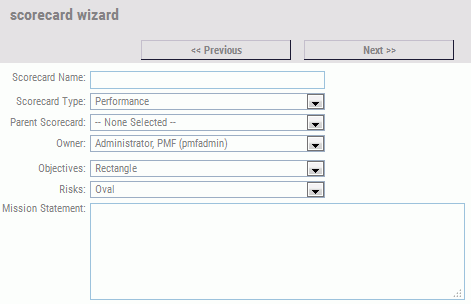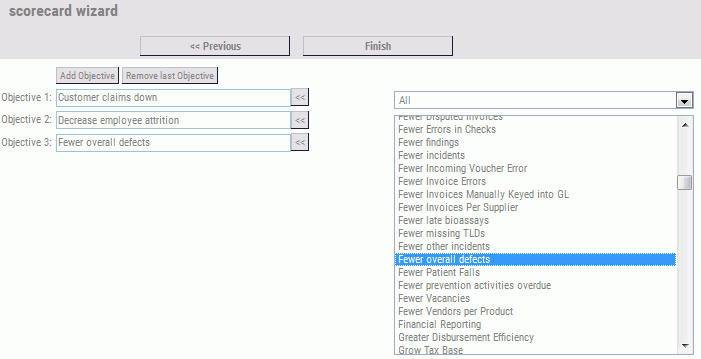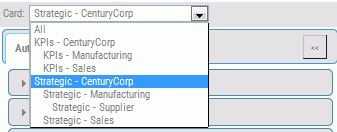|
|
|
Procedure: How to Create a New Scorecard Using the Scorecard Wizard
- In the Author page, click the Scorecards panel button.
- Click
the Wizard button.
The Scorecard Wizard panel opens, as shown in the following image.

- Complete
the fields in the panel, as described in the following table.
Field
Description
Scorecard Name
Type a name for your new Scorecard. The maximum number of characters is 50.
Scorecard Type
Select Performance or Risk.
Parent Scorecard
If the Scorecard should be cascaded from a parent, select the desired parent scorecard. All scorecards that you have access to are shown in the drop-down menu.
Owner
Select the user ID of the owner of the scorecard. By default, your owner ID is used.
Objectives
Select the shape to use for Objectives in the Strategy Map. Choose Oval, Rectangle, Rounded Rectangle, Wide Oval, Wide Rectangle, or Wide Rounded Rectangle.
Risks
Select the shape to use for Risks in the Strategy Map. Choose Oval, Rectangle, Rounded Rectangle, Wide Oval, Wide Rectangle, or Wide Rounded Rectangle.
Mission Statement
Optionally, type text to describe the fundamental purpose of the new scorecard. This information is displayed in the Strategy Map and in some views.
- Click Next.
- Select the Use default Perspectives check
box or type a value in each of the four Perspective fields.
Note: You can click Previous at any time before the Finish step to go back and make changes.
- Click Next.
The next panel, used to add objectives, opens, as shown in the following image.

- For each new objective that you want to add, select an objective category
from the drop-down menu (to the right of Objective 1), and double-click
the desired item in the objective selection box, which is located
below the objective category drop-down menu.
You can also do any of the following:
- Replace an objective that was already selected. Highlight an item in the objective selection box and click the left-pointing arrow to the right of the existing objective.
- Manually add an objective name. Click the Add Objective button and type the name of the desired objective in the blank objective field. Note that when you do this, you will have to also manually type a name for the associated measure.
- Remove the last objective. Click the Remove last Objective button.
- Click Next to review all of the corresponding measures for the objectives you selected on the previous page.
- If you have no further changes, click Finish. Otherwise,
click Previous.
When you click Finish, a summary page is displayed for the new scorecard you just created. You can click Go to card to view the new scorecard or click Another new to create another new scorecard.
Your new scorecard is now set up and ready to use.
For more information about editing a scorecard created by the Scorecard Wizard, see Editing, Deleting, and Creating Scorecards. For example, you can add a mission statement to the scorecard or select the shape for displaying objectives on the Strategy Map.

